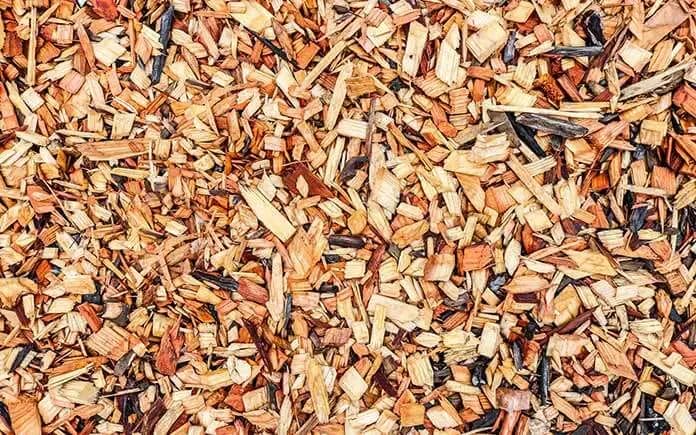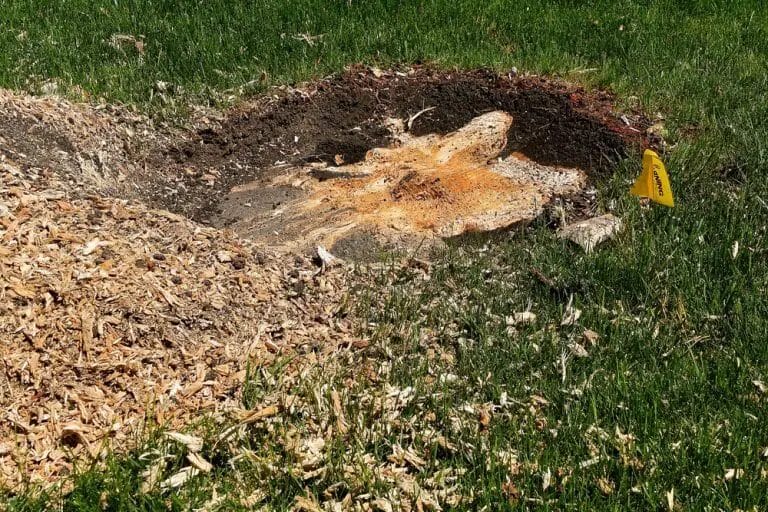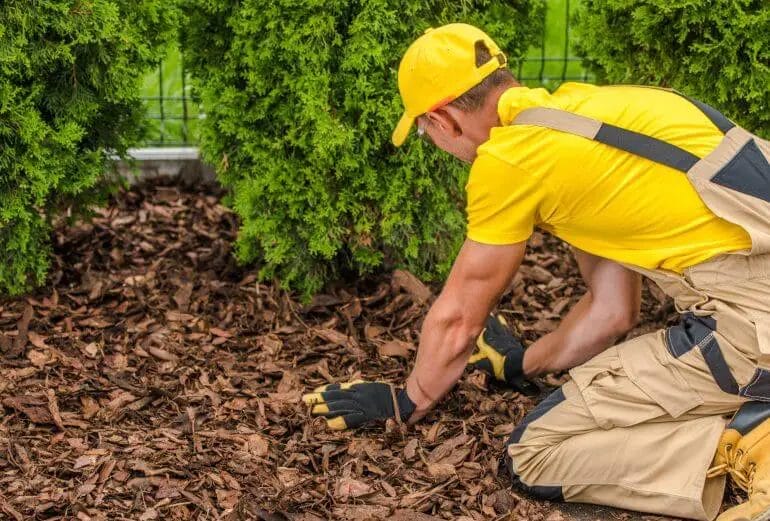If you’ve recently had a tree stump removed, you’re likely left with a pile of wood chips. Instead of letting them go to waste, there are several creative ways to repurpose these wood chips.
One option is to use them as mulch in your garden beds, which can help retain moisture, control weeds, and improve soil health. Another idea is to turn them into compost, as wood chips provide valuable carbon-rich material for a balanced compost pile.

If you have a fireplace or wood-burning stove, you can also use the wood chips as a source of fuel. They can be dried and seasoned for future use, providing a sustainable and cost-effective alternative to firewood.
Additionally, wood chips can be used for decorative purposes, such as pathways or as a natural surface for playgrounds. They provide a rustic and environmentally-friendly option.
Remember to consider the type of wood that was chipped, as certain woods may be more suitable for specific uses. Overall, finding a productive way to utilize your wood chips can help minimize waste and maximize their potential benefits.

Benefits of Mulching with Wood Chips
Mulching is a common practice in gardening and landscaping that involves applying a layer of material on top of the soil to provide several benefits. One popular mulching material is wood chips, which are obtained from chipped or shredded wood. Wood chip mulch offers numerous advantages for soil health and plant growth. In this section, we will explore the benefits of mulching with wood chips.
1. Weed Suppression
One of the primary benefits of using wood chips as mulch is their ability to suppress weeds. When a layer of wood chips is applied to the soil, it acts as a natural barrier, preventing sunlight from reaching weed seeds and preventing them from germinating. This can significantly reduce weed growth in your garden or landscape beds, saving you time and effort in weed control.
2. Moisture Retention
Wood chip mulch is an excellent moisture retainer. It helps to reduce evaporation from the soil surface, keeping the soil consistently moist. By retaining moisture, wood chip mulch provides a more stable environment for plants, especially during hot and dry periods. This can reduce the frequency of watering and help conserve water in your garden.
3. Soil Temperature Regulation
Wood chips act as an insulating layer on the soil surface, helping to regulate soil temperature. In hot weather, they provide shade and prevent excessive heating of the soil, protecting plant roots from heat stress. In colder climates, wood chips help to insulate the soil and prevent drastic temperature fluctuations that could harm plant roots. By maintaining a more stable soil temperature, wood chip mulch creates an optimal environment for plant growth.
4. Nutrient Enrichment
As wood chips slowly decompose over time, they release nutrients into the soil. These nutrients, including nitrogen, phosphorus, and potassium, are essential for plant growth. The decomposition process of wood chips also enriches the soil with organic matter, improving its structure and fertility. This nutrient enrichment promotes healthier and more vigorous plant growth.
5. Erosion Control
Wood chip mulch effectively reduces soil erosion caused by heavy rainfall or wind. The layer of wood chips acts as a protective barrier that prevents the soil from being washed away or blown off by strong winds. By reducing erosion, wood chip mulch helps to maintain soil integrity and prevents nutrient loss, ensuring a stable and productive growing environment for your plants.
6. Pest and Disease Control
Using wood chips as mulch can also contribute to pest and disease control. Some wood species, such as cedar or cypress, contain natural compounds that act as repellents against certain pests, including insects and fungi. These natural repellents can help protect your plants from common garden pests and diseases, reducing the need for chemical pesticides.
7. Aesthetically Pleasing
Lastly, wood chip mulch can enhance the aesthetic appeal of your garden or landscape beds. The natural texture and color of wood chips create a visually pleasing and cohesive look, adding a touch of beauty to your outdoor space. Wood chips also help to define planting areas and pathways, giving your garden a well-maintained and organized appearance.
In summary, mulching with wood chips offers a range of benefits for soil health and plant growth. From weed suppression and moisture retention to nutrient enrichment and erosion control, wood chip mulch is a versatile and sustainable choice for your garden or landscape. Consider incorporating wood chips into your mulching routine to enjoy these advantages and create a thriving and beautiful outdoor environment.

Composting with Wood Chips
Composting is a natural process that helps turn organic waste into nutrient-rich soil amendment. It’s not only beneficial for the environment but also for your garden as it provides the essential nutrients that plants need to thrive. While there are various materials that can be added to a compost pile, one particularly useful addition is wood chips. In this section, we will explore how you can effectively incorporate wood chips into your compost pile to create nutrient-rich soil amendment.
1. Understanding the Benefits of Wood Chips
Wood chips offer several benefits when added to a compost pile:
- Absorption: Wood chips have the ability to absorb excess moisture in the compost pile, preventing it from becoming too wet and causing anaerobic conditions.
- Aeration: The coarse texture of wood chips helps create air pockets in the compost pile, promoting proper airflow and oxygenation for the beneficial microbes involved in the decomposition process.
- Carbon Source: Wood chips are rich in carbon, which is an essential component for a balanced compost pile. By adding wood chips, you ensure a good carbon-to-nitrogen ratio, which is crucial for effective composting.
- Nutrient Release: As wood chips break down, they release nutrients slowly over time, providing a long-lasting source of nutrition for plants.
2. Incorporating Wood Chips into Your Compost Pile
Here are some guidelines to effectively incorporate wood chips into your compost pile:
- Shred or Chip: Start by shredding or chipping the wood into smaller pieces. This increases the surface area, allowing for faster decomposition.
- Mix in Layers: Alternate layers of wood chips with other organic materials such as kitchen scraps, yard waste, and grass clippings. Aim for a ratio of 3 parts carbon-rich materials (like wood chips) to 1 part nitrogen-rich materials.
- Moisture Management: Ensure that the compost pile is adequately moist, but not overly wet. Wood chips tend to absorb moisture, so monitor the moisture levels and adjust accordingly.
- Aeration: Turn or mix the compost pile regularly to promote airflow and prevent compaction. This also helps distribute the wood chips evenly throughout the pile.
- Patience: Composting with wood chips may take longer compared to other materials due to their high carbon content. Be patient and allow sufficient time for the wood chips to break down completely.
3. Considerations and Tips
While wood chips can be a valuable addition to your compost pile, there are a few considerations to keep in mind:
- Source of Wood Chips: Ensure that the wood chips you use are from untreated wood, as treated wood may contain chemicals that can be harmful to plants.
- Size of Wood Chips: Smaller-sized wood chips will decompose faster compared to larger pieces. Consider shredding or chipping the wood into smaller sizes for quicker composting.
- Proportions: Maintain a balance between carbon-rich materials (such as wood chips) and nitrogen-rich materials for optimal composting. Adjust the proportions as needed to achieve the desired results.
Summary
Composting with wood chips is a great way to enhance your compost pile and create nutrient-rich soil amendment for your garden. By understanding the benefits of wood chips and following proper techniques, you can effectively incorporate them into your compost pile. Remember to source untreated wood chips, shred or chip them into smaller sizes, and maintain a good balance of carbon-rich and nitrogen-rich materials. With patience and regular maintenance, you will soon have nutrient-rich compost to nourish your plants and promote healthy growth.

Wood Chip Pathways and Landscaping
If you’re looking for a natural and visually appealing way to enhance your outdoor space, wood chip pathways and landscaping features are a great option. Not only do they add charm and character to your garden, but they also offer several practical benefits. In this section, we’ll explore the various ways you can use wood chips to create stunning pathways and landscaping designs.
1. Pathways
Wood chip pathways are a popular choice for many homeowners due to their rustic and natural look. They blend effortlessly with any garden style, whether it’s a modern landscape or a traditional cottage garden. Here are some ideas to inspire you:
- Create a winding path through your garden using wood chips. This adds a sense of intrigue and encourages visitors to explore.
- Use different wood chip colors and sizes to create patterns or mosaic designs within your pathway.
- Combine wood chips with other materials like stepping stones or gravel to add texture and variety.
- Consider incorporating edging materials such as logs or stones to define the pathway and prevent the wood chips from spreading.
2. Garden Beds
In addition to pathways, wood chips can be used to enhance your garden beds and create visually appealing landscaping features. Here are some ideas to consider:
- Use wood chips as a mulch around your plants and flowers. This not only adds an attractive layer to your garden beds but also helps retain moisture and suppress weed growth.
- Create raised garden beds using wood chips as the border. This adds a rustic touch and provides a defined space for your plants.
- Build natural-looking retaining walls using stacked logs or timber. Fill the space behind with wood chips to create a seamless transition between the wall and the surrounding garden.
3. Play Areas
If you have children, wood chip play areas can be a great addition to your outdoor space. They provide a soft and safe surface for kids to play on and can be designed in various ways:
- Create a designated play area with wood chips as the base. This helps cushion falls and reduces injuries.
- Consider building a small wooden play structure or sandbox within the play area to add extra fun and excitement.
- Incorporate natural elements like tree stumps or logs for climbing and balancing activities.
In summary, wood chip pathways and landscaping features offer a natural and visually appealing way to enhance your outdoor space. Whether you’re looking to create winding pathways, enhance your garden beds, or design a play area for children, wood chips can be a versatile and practical choice. Get inspired by these ideas and start transforming your garden into a beautiful and inviting space.
Sustainable Fuel and Biomass
In this section, we will explore the potential for using wood chips as a renewable energy source or biomass material in various applications. Wood chips are a type of biomass that can be derived from various sources such as logs, branches, and sawmill residues. They have been gaining attention as a sustainable fuel alternative due to their renewable nature and low carbon emissions.
1. Renewable Energy Source
Wood chips have emerged as a promising renewable energy source due to their abundant availability and carbon-neutral properties. They can be used as a fuel in biomass power plants to generate electricity or as a heat source for industrial processes and residential heating.
The use of wood chips as a renewable energy source offers several advantages. Firstly, it reduces reliance on fossil fuels, thereby mitigating greenhouse gas emissions and promoting environmental sustainability. Secondly, it provides a reliable and locally sourced energy supply, reducing dependence on imported fuels. Additionally, the utilization of wood chips can support the growth of the forestry industry and create job opportunities in rural areas.
However, it is important to ensure the sustainable management of forests to prevent overexploitation and maintain a balance between the demand for wood chips and the availability of biomass resources. Forest certification programs, sustainable harvesting practices, and reforestation efforts can help ensure the long-term viability of using wood chips as a renewable energy source.
2. Biomass Material
Beyond energy production, wood chips can also be utilized as a biomass material in various applications. One such application is in the production of biofuels, specifically wood-based ethanol. Wood chips can be processed to extract cellulose, which can then be converted into ethanol through biochemical or thermochemical processes.
In the construction industry, wood chips can be used as a sustainable alternative to traditional construction materials. They can be incorporated into composite materials for insulation, particleboards, and even as a component in concrete mixtures. By utilizing wood chips as a biomass material in construction, the demand for non-renewable resources can be reduced, leading to a more sustainable and environmentally friendly approach to building.
Furthermore, wood chips can be utilized in the agricultural sector as a soil amendment or mulch. They can improve soil quality, retain moisture, and suppress weed growth. The slow decomposition rate of wood chips ensures long-lasting benefits, making them a cost-effective and sustainable option for enhancing soil health.
Summary
Wood chips have immense potential as a renewable energy source and biomass material. Their utilization can contribute to reducing carbon emissions, promoting sustainable energy production, and creating a circular economy. By maximizing the benefits of wood chips while ensuring sustainable forestry practices, we can harness their potential to drive a greener and more sustainable future.
FAQs
1. What should I do with wood chips from stump grinding?
Wood chips from stump grinding can be used in various ways. You can spread them as mulch in your garden beds to help retain moisture and prevent weed growth. They can also be used as a natural pathway material or as a base for composting. Alternatively, you can contact your local recycling center or tree service to inquire about their wood chip disposal options.
Conclusion:
In conclusion, when it comes to deciding what to do with wood chips from stump grinding, there are several options to consider. Firstly, these wood chips can be utilized as a natural mulch, providing valuable nutrients to the soil and aiding in moisture retention. Alternatively, you can use them as a surface covering for walking paths and garden beds, enhancing the aesthetic appeal of your outdoor space. Additionally, these wood chips can be composted to create nutrient-rich organic matter for your garden. Finally, if none of these options suit your needs, you can consider contacting local tree removal services or landscaping companies, as they might be interested in acquiring the wood chips for their own purposes. Overall, with a little creativity, these wood chips can find new life and serve a purpose beyond just being waste.